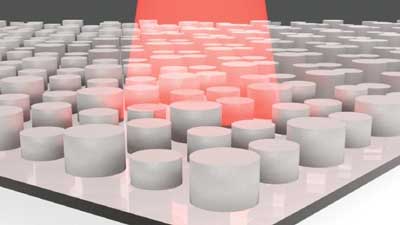| Feb 05, 2020 | |
Machine learning accelerates metamaterial design(Nanowerk News) Metamaterials are artificially made materials that have certain patterns that change how light and matter interact. As a result, they have properties not found in nature. Researchers are increasingly using computer models to predict how light will interact with metamaterials. However, it’s hard to predict which metamaterial will produce a desired property. |
|
| Scientists used machine learning techniques to analyze databases of information (Optics Express, "Deep learning for accelerated all-dielectric metasurface design"). The computer program predicted the ideal metamaterial design for absorbing low-energy light. | |
| Conventional models would have taken more than two thousand years to find the best metamaterial. In contrast, the machine learning program calculated the solution in twenty-three hours. | |
 |
|
| Infrared light shining on a metamaterial whose geometric parameters were selected with machine learning. The designed metamaterials effectively absorb low energy light, providing a route to new devices that turn heat into electricity. (Image: Willie Padilla, Duke University) | |
| Machine learning is emerging as an important tool for advancing fundamental science. In this research, scientists used a type of machine learning known as a deep neural network to model how artificial materials (metamaterials) would absorb infrared light. | |
| The scientists designed a metamaterial that absorbs many wavelengths of infrared light but emits very few. This approach may enable scientists to develop practical thermophotovoltaic devices. These devices create electricity from heat instead of light. | |
| Computer models of infrared optical absorption and emission from a metamaterial were used to fabricate novel metamaterials. The final design was a square array of cylindrical silicon pillars with varying radii and heights. | |
| To choose the geometric details, scientists trained a deep neural network with 18,000 individual simulations of potential designs. The network then modeled a much larger set of metamaterial designs. | |
| Because this approach was nearly one million times faster than the modeling software that was used to train the neural network, the authors were able to calculate the properties of every relevant metamaterial design in only twenty-three hours. After calculating the optical properties of all possible designs, a search algorithm selected the best design. | |
| These new techniques significantly increase the viability of more complex all-dielectric metasurface designs and provide opportunities for the future of tailored light-matter interactions. |
| Source: Duke University | |
|
Subscribe to a free copy of one of our daily Nanowerk Newsletter Email Digests with a compilation of all of the day's news. |
